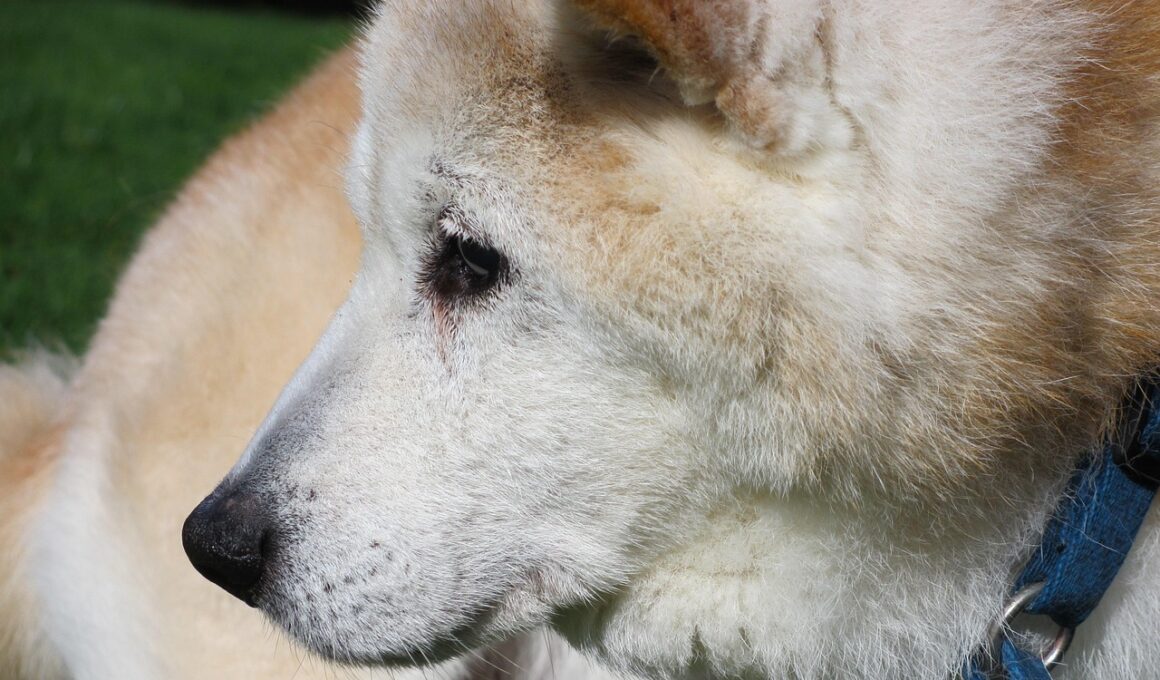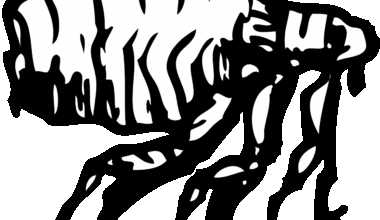Vision Problems in Senior Dogs: Symptoms and Care Tips
As dogs age, they may face various health challenges, and vision problems are among the most common. Senior dogs can develop cataracts, glaucoma, or conditions affecting the retina. Identifying vision issues early can help improve your dog’s quality of life. Some symptoms to look for include subtle changes in behavior and difficulty navigating familiar areas. For instance, you may notice your dog hesitating before stairs or bumping into furniture. These aren’t just signs of aging; they could indicate serious vision problems. Regular eye examinations by a vet are crucial for your older pet. If you observe any unusual behavior, scheduling an appointment is advisable. Ensuring early detection allows for better management of their condition. Additionally, senior dogs may show increased sensitivity to changes in environment, lighting, or sudden movements. Being aware of these symptoms is vital for pet owners wishing to provide the best care to their aging companions. You should remain observant and document changes to discuss with your veterinarian. Remember, early intervention can lead to improved outcomes and a happier, more comfortable life for your beloved senior dog.
Maintaining a safe environment is crucial for senior dogs experiencing vision problems. As you notice signs of impaired vision, you can help them navigate safely in their home. To create a secure environment, keep pathways clear of obstacles and ensure that your dog has access to familiar areas. Removing sharp objects or potential hazards can prevent injuries. Consider using non-slip mats to ensure your dog can walk safely on various surfaces. You might also employ baby gates to block off stairs or rooms they should avoid. Additionally, maintaining consistent furniture placement can reduce confusion for a visually impaired dog. Familiar scents can help them navigate their surroundings, so consider using scent markers in critical areas. It is essential to keep your dog emotionally secure during this transition. Avoid sudden changes that could further exacerbate their fears. Encouraging positive experiences related to their environment can build their confidence. You can talk to them soothingly as they explore new spaces or guide them gently with light pressure on their harness. This will help your dog feel safe and supported. Consistency, patience, and love are your best tools when caring for a senior dog with vision problems.
Vision Problems and Behavioral Changes in Senior Dogs
Senior dogs experiencing vision problems may also exhibit behavioral changes. These behavioral shifts can be alarming for pet owners, as they may seem unusual or concerning. For example, a once sociable dog may become withdrawn or anxious, particularly when faced with unfamiliar surroundings or other pets. Increased barking or growling may also manifest, especially if a dog feels threatened or startled due to diminished sight. It is crucial to identify these changes as potential reactions to vision loss, rather than mere behavioral issues. Providing your dog with consistent routines and engaging activities can help manage anxiety and promote a calmer demeanor. Consider incorporating interactive toys that stimulate your dog’s mind, as well as activities that satisfy their natural instincts. Physical exercise is vital too, as it can reduce stress and improve overall well-being. Encouraging gentle socialization with familiar friends or family can foster positive experiences for your pet. Be sensitive to their evolving needs and understand that patience is key. Consulting a veterinarian about behavioral aids can provide further guidance in supporting your senior dog through this challenging period. Remember, love and understanding will aid in your dog’s adaptation to their vision challenges.
When dealing with vision problems in senior dogs, your approach to training may need to adjust. Standard commands and cues that worked previously might require modifications or additional reinforcement. Utilizing auditory signals or touch-based commands can provide the guidance your dog needs as they cope with vision loss. Frequent practice and repetition will help reinforce their confidence. It’s crucial to remain patient and understand that learning new approaches may take time for both you and your pet. For instance, using a distinctive sound or voice commands can help your dog familiarize themselves with their surroundings without relying strictly on vision. Gradually introducing them to new areas can prevent overwhelming experiences and build their spatial awareness. Ensure that you reward positive behavior and reassure them with affection. Also, practicing recall commands in a safe, enclosed area can help promote their awareness and response in diverse environments. Understand the pace at which your dog learns best and adjust your strategies accordingly, maintaining an encouraging atmosphere. This personalized approach will go a long way in helping your senior dog adapt effectively to their vision impairment, fostering a sense of security and trust in you.
Veterinary Care for Vision Issues
Regular veterinary care is essential for senior dogs dealing with vision problems. Veterinary professionals possess the expertise required to diagnose specific conditions accurately. Assessing whether your dog suffers from cataracts, glaucoma, or other eye issues typically involves thorough examinations. These can include visual acuity tests, tonometry, and retinal assessments. Depending on the diagnosis, tailored treatment plans may be outlined to meet your dog’s needs optimally. Surgery is a common intervention to restore vision in cases like cataracts, while conditions like glaucoma may require ongoing management. Regular follow-up appointments will help to monitor the progression of any diagnosed conditions. Furthermore, your veterinarian can recommend supplements that may support eye health. In some cases, specialized diets catering to older dogs may also be beneficial. Additionally, educating yourself about your dog’s specific condition can help you better advocate for their needs. Don’t hesitate to ask questions and express concerns to your vet, ensuring clear communication. By providing thoughtful care and investing time in understanding your dog’s vision health, you can significantly enhance their overall quality of life and happiness.
Creating a comfortable home environment is an essential part of caring for senior dogs with vision issues. Introducing modifications can enhance their sense of security. For instance, using dim lighting or softer contrasts can ease their navigation. Additionally, opting for safety gear like harnesses can aid in control when walking outdoors. Consider using brightly colored collars and leashes to set visual cues in low-light environments. You can even use tactile elements to aid your dog, such as textured mats or rugs to delineate spaces. It’s beneficial to have designated areas for eating, sleeping, and playing. This allows your dog to learn and remember where their important zones are. By maintaining consistency, you can help them navigate their environment more effectively. Establishing a routine can also be reassuring, reducing anxiety related to uncertainty. Allowing your dog to explore new items and spaces at their own pace can foster adaptability. If they struggle, remain patient and offer guidance. Planning activities that engage their other senses, such as scent games, can further accommodate their changing needs. With a few thoughtful adjustments, you can create a cozy haven that supports your senior dog’s well-being effectively. Your efforts will greatly enhance their comfort and happiness through their golden years.
Concluding Thoughts on Senior Dog Vision Care
In conclusion, managing vision problems in senior dogs requires a compassionate and proactive approach. Being attentive to your dog’s changing needs is vital as they adapt to various challenges with aging. Recognizing symptoms of vision impairment early ensures timely veterinary care, which can be critical for their quality of life. Care strategies including environmental modifications and new training methods can significantly impact their emotional well-being. Always work closely with your veterinarian to establish a tailored care plan based on your dog’s unique requirements. Remember, patience and understanding are cornerstones in helping your dog adapt during this transition. Encouraging positive experiences allows your senior dog to feel safe in their surroundings, promoting their overall happiness and confidence. Engage with your dog in gentle, soothing ways to foster their trust in you as a caregiver. With the right support, your beloved canine can continue to thrive, enjoying their senior years to the fullest. Your dedication to understanding and adapting to their needs will elevate their quality of life. Emphasizing love, care, and attention will show them they’re cherished members of the family in every sense, even as their vision may wane. Your efforts will create a lasting bond.
With senior dogs facing various health challenges, including vision problems, your commitment is more essential than ever. You play a critical role in their lives, providing love, support, and understanding. Through your efforts, they can navigate their limitations with grace and dignity. By embracing adaptations in your home and routines, you empower your dog to live comfortably and joyfully despite any challenges associated with aging. Diligent observation of their behavior and routine vet visits ensure they receive the tailored care they need. Remember that vision problems can intersect with other age-related conditions, so maintaining a holistic view of their health is crucial. Reflecting on their quality of life can help you make choices that prioritize their comfort and happiness. You’ll create an environment rich in love, acceptance, and care that encourages your dog’s resilience. Your contributions will undoubtedly uplift their spirits and strengthen your bond. Together, you and your senior dog can navigate this journey, creating meaningful connections through trust, patience, and understanding. The joy derived from your companionship only deepens as you adapt to each stage of their lives with unwavering devotion. Love remains a powerful healer, transcending barriers, and enhancing their journey ahead.


